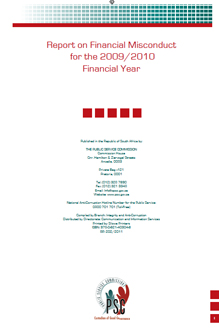|
Getting your Trinity Audio player ready...
|
 Corruption is most likely to occur among lower level government employees and those employed within the justice cluster, which includes the police, courts and correctional services, according to a recently released report.
Corruption is most likely to occur among lower level government employees and those employed within the justice cluster, which includes the police, courts and correctional services, according to a recently released report.
The report, released to parliament by the Public Service Commission (PSC) in the first week of March 2012, probed financial misconduct in 39 national state departments and nine provincial governments during the 2009/10 financial year.
It shows that despite repeated recommendations to national and provincial departments, the amount being lost to financial mismanagement is escalating and fewer cases are being finalised.
The term “financial mismanagement” includes fraud, corruption and irregular expenditure.
Dr Johan Burger of the Institute for Security Studies, which conducts research on the justice sector, said “we are seeing financial mismanagement at all levels in the justice cluster".
"The police are the most noticeable because they have the largest number of employees, but we are seeing it in the courts and at correctional services level, although the kind of mismanagement occurring differs from one department to another.”
Burger’s findings mirror those of the PSC, namely that financial mismanagement is likely to occur among lower levels of staff. According to a PSC staff member, financial mismanagement is occurring among level one to level 10 staff members and involves relatively small amounts.
“Staff at lower levels have more access to people because they make up the front line,” said Burger, “but they are likely to ask for relatively small bribes. We are not seeing large bribes, certainly not in the millions.”
This, he said, also makes detection of the crime harder because it would require consistent financial mismanagement before lifestyle changes could be detected or the alarm raised.
The PSC’s Roderick Davids said their research had highlighted many unaddressed supply chain management issues, which remained despite yearly recommendations by the PSC on how to improve both detection and resolution of financial mismanagement.
Justice Minister Jeff Radebe and justice officials agree that the justice, crime prevention and security cluster has problems.
In February 2012 Radebe noted that in the last financial year “192 officials were charged with corruption, 86 convicted, and 294 charged departmentally with misconduct”.
The justice cluster has continued to be the worst offender for a number of years, according to PSC data.
According to the justice department, a report has been compiled to delve into the nature and extent of the corruption, theft of equipment and interference with evidence intended for trial purposes. This investigation was done to strengthen controls within the department’s ranks.
Commenting on the report, PSC deputy chairperson Phelele Marilyn Tengeni said the probe indicated ongoing “weaknesses in risk management and control systems in departments”.
The report depends on national and provincial departments filing data on their finalised financial mismanagement cases.
A source at the PSC said the organisation had resorted to surprise visits to some national and provincial government departments where compliance and reporting is low.
Davids added that some of these departments may be very good when it comes to detection, but could be weak at resolution.
Tengeni has raised concern about the number of people who resigned before disciplinary cases could be finalised, and the lack of detailed data on the nature of the financial mismanagement and the official concerned – particularly the employee level they held within the department.
The PSC said government officials had proved to be very good detecting weaknesses in systems and then exploiting them.
Business is struggling with similar problems. A recent Deloitte investigation, which profiled the type of employees most likely to commit fraud, warned that there was no replacement for good oversight and detection systems.
Burger found that oversight and inspections among the justice sector were very weak or, in many cases, non-existent.
The problem with corruption and fraud, as one PSC employee commented, is that “we can only document what we have uncovered, it’s a hard area to quantify”.
In the provincial section of the PSC report, KwaZulu-Natal reporting the highest number of finalised financial misconduct cases (30.5%), followed by the Western Cape at 23.4%.
KwaZulu-Natal has had the highest number of finalised cases three years running.
Tengeni admits that it’s hard to determine whether such results are an accurate indicator of actual mismanagement because the data is submitted by the provinces themselves.
Tengeni’s position is supported by Burger, who believes it’s important to compare “like with like”.
Findings in another PSC report, on the organisation’s anti-corruption hotline, suggest that KwaZulu-Natal cannot be considered to have more crime simply because it has the greatest number of finalised cases.
The hotline report reveals that the greatest number of cases referred to Gauteng (1 188), followed by Mpumalanga (791). KwaZulu-Natal had 409 corruption cases referred to it by the PSC.
Snapshot of financial misconduct for 2009/10, according to the PSC report:
- Cost of financial mismanagement was R346-million, against R100-million in 2008/9.
- R44-million was recovered against R302-million lost to corrupt activities.
- 489 officials were given final written warnings, 214 were fired and 245 are facing criminal charges.
- KwaZulu-Natal reported 259 of the 1 135 finalised cases.
- The justice department reported 93 cases of financial mismanagement and correctional services 48.
- Fraud made up 52.9% of the overall number of cases reported by departments.
Download the full documents here:
![]()
